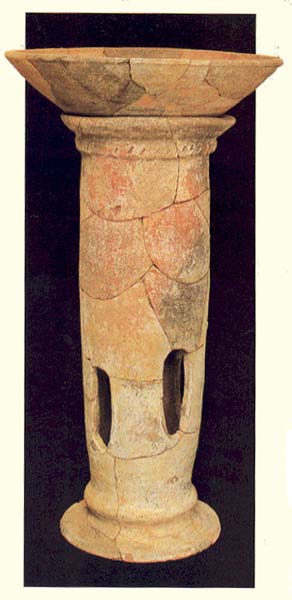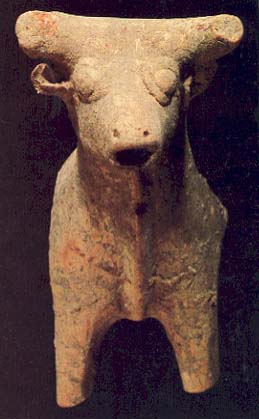Shiloh Yields Some, But Not All, of Its Secrets
Location of Tabernacle still uncertain
022

In the first half of the 11th century B.C., Shiloh was one of the most important sites in the central mountain ridge that runs through the Land of Israel. Here was the sacred religious center of the Israelite population of the hill country. Here the Ark of the Covenant rested within the Tabernacle for nearly a century, until the Ark itself was captured by the Philistines in the battle of Ebenezer (1 Samuel 4). Here Eli served as high priest. Here Samuel, prophet and seer, grew up and served the Lord.
Interestingly enough, Shiloh is not mentioned in the patriarchal narratives. Nor is it mentioned in Egyptian documents from the New Kingdom (15th to 12th centuries B.C.).
Shiloh first appears in the Bible in descriptions of the Israelite Settlement in Canaan and in an episode from the period of the Judges. According to the Bible, it was at Shiloh that the land was divided among the tribes (Joshua 18:10) and the Levitical cities were allotted (Joshua 21:2). Here the people gathered in times of distress (Joshua 22:12), 024as well as for annual religious festivities (Judges 21:19–21).
Shiloh’s importance both as a religious center and as the seat of the leadership of the Israelite tribes reached its zenith toward the end of the period of the Judges, that is, during the first half of the 11th century B.C., the time of Eli and Samuel (1 Samuel 1–4).
Shiloh also figures prominently in dramatic events surrounding the battle with the Philistines near Ebenezer (1 Samuel 4), in the western approach to the hill country, not far from the coastal plain. When the battle was going badly for the Israelites, they had the Ark of the Covenant brought from Shiloh to lead them. But it was to no avail; the Philistines were victorious and captured the Ark.

After defeating the Israelites, the Philistines apparently took advantage of their victory to press on up to the hills and burn Shiloh to the ground. The Bible does not explicitly report the destruction of Shiloh, but the fiery end is alluded to a number of times in the Book of Jeremiah (Jeremiah 7:12–14, 26:6, 26:9) and in Psalms (78:60). Hundreds of years after the Philistine destruction of Shiloh, the prophet warns the people in the name of the Lord:
“Just go to My place at Shiloh, where I had established my name formerly, and see what I did to it because of the wickedness of My people Israel … Therefore I will do to the House which bears My name, on which you rely, and to the place which I gave you and your fathers just what I did to Shiloh” (Jeremiah 7:12, 14).
Obviously the meaning of Shiloh’s destruction had remained vivid. As we shall see, this destruction has now been confirmed by excavation.

Following the devastation of Shiloh, the Israelite center moved south to the territory of Benjamin and subsequently to Jerusalem. Shiloh remained deserted for a while, but by the reign of Jeroboam I (928–907 B.C.), king of the northern Kingdom of Israel, settlement at Shiloh had been renewed (1 Kings 14:2, 4), and there was still a settlement at the time of the destruction of the First Temple in 586 B.C. (Jeremiah 41:5).
Although the site was thereafter occupied almost continuously until the late Middle Ages, it never regained the importance it had achieved in the time of the Judges. Rabbinic sources, church literature, and pilgrims’ accounts from the Byzantine period contain references to Shiloh; and its location was still known in the Middle Ages when the Jewish traveler Eshtori ha-Parhi found it in ruins.
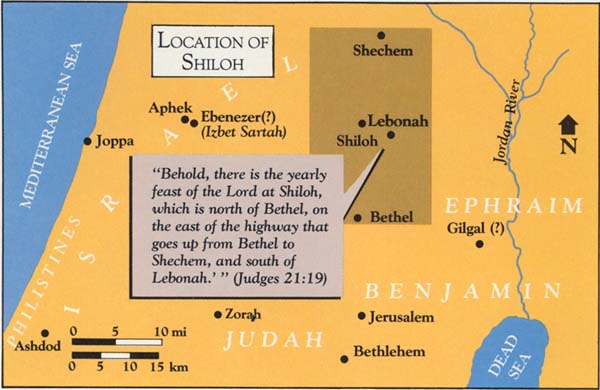
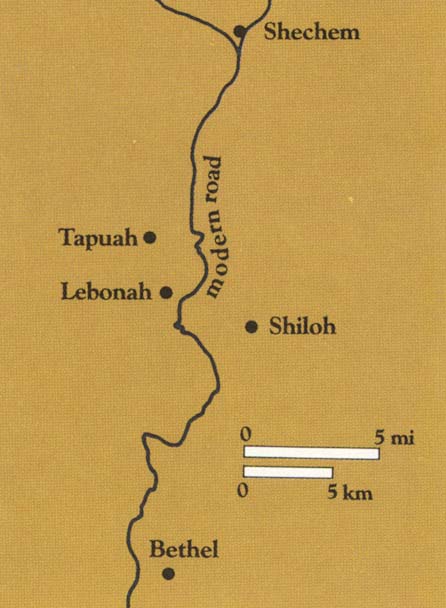
During his travels in the Holy Land in the 1830s, the American Orientalist Edward Robinson identified Khirbet Seilun (the ruin of Seilun) with ancient Shiloh. Actually, making this identification was comparatively easy. Not only was the site still known in the Middle Ages, but the historical sources provided relatively specific descriptions of its location. The credit for locating Shiloh really goes to the exceptionally detailed geographical data provided by the Book of Judges where we are told: “Behold, there is the yearly feast of the Lord at Shiloh, which is north of Bethel, on the east of the highway that goes up from Bethel to Shechem, and south of Lebonah” (Judges 21:19). The identification of Bethel with the village of Beitin, northeast of Ramallah, is well known; Lebonah must be located in the vicinity of the village of Lubban Sharqiya, near Shiloh on the northwest; and the “highway,” the ancient route, apparently followed a course close to that of the modern Jerusalem-Nablus road. The Onomasticon of Eusebius (fourth 025century A.D.) places Shiloh “ … twelve miles [from Neapolis (Shechem)] at Acrabitene,” that is, in the district named after the city whose name is still preserved in the name of the Arab village of Aqraba, northeast of Shiloh. As if all these literary references were not sufficient, the ancient name of Shiloh was preserved in the name of the Arab village of Seilun, still known in the 16th century (but later deserted). The identification of the site is thus sure. And, as we shall see, the excavated remains accord with the history of the site as reflected both in the Bible and in other written sources.
The tella of Shiloh is located in the heart of the territory of Ephraim, just east of the Jerusalem-Nablus road (as the Bible says), at the northern end of a fertile valley surrounded by hills. Almost a half-mile northeast of the tell is a large spring that supplements the runoff water collected in the cisterns on the mound itself.
The tell covers less than eight acres. The eastern, western and northern sides of the tell slope quite steeply, so the most convenient approach is—and was—from the south; indeed, it seems that the entrance to Shiloh was always on the southern side, but, as we shall see, this is precisely where excavation would be unprofitable because later construction has removed earlier remains.
Three considerations determined the location of Shiloh: proximity to the fertile valley, availability of a dependable water source and defensibility of the mound.
Shiloh was first excavated in 1922 by Aage Schmidt of Denmark, who conducted a few trial soundings. Schmidt became so excited by the site that he decided to organize a major excavation. He sought the support, among others, of Winston Churchill, then British minister of the colonies; of General Allenby, who captured Jerusalem from the Turks in 1917, and of Lord Balfour, whose name is attached to the famous Balfour Declaration that did so much to further the cause of a Jewish state in Palestine. As a result of Schmidt’s efforts, a Danish expedition headed by Hans Kjaer fielded three campaigns at Shiloh between 1926 and 1932. Four areas were then explored, the most important being on the northwest and western margins of the site. Unfortunately, in the 1932 season, Kjaer contracted dysentery; he was taken to Jerusalem, where he soon died. As a result, Schmidt and Nelson Glueck, the famous American archaeologist who helped Kjaer with pottery dating, closed the excavation.
For various reasons, including objective difficulties, this Danish expedition failed to achieve a clear picture of 026the history of the site. In 1963, another Dane, Svend Holm-Nielsen, dug test pits in several places on the tell, including the summit, but added little to what was already known.
The excavation of Shiloh was resumed in 1981, this time under the aegis of the Department of Land of Israel Studies at Bar-Ilan University,1 and four seasons of excavation were undertaken.
Our work on the tell, however, is but one aspect of a much larger and more comprehensive regional study that includes surveying the entire territory of the tribe of Ephraim, one of the most important of the tribes of Israel. The area of the survey covers about 400 square miles (1,050 square kilometers), bounded by Shechem on the north, Ramallah on the south, the fringes of the desert on the east, and the foothills of the central mountain range on the west. Although this region is located in the heartland of the historical Land of Israel, it is, strangely enough, practically terra incognita, archaeologically speaking. Our survey is emphasizing various environmental conditions and their influence on the pattern of settlement in each period. Thus far, we have located and examined more than 500 sites, many of which were previously unknown. The excavation of Shiloh and the survey of Ephraim are, as we shall see, closely connected. But now, let us return to the excavation.
When we began our excavation, we were immediately confronted with two typical problems in excavating hilltop sites: the summit of the tell had badly eroded, exposing bedrock in many places. Secondly, since construction in all periods attempts to lay building foundations directly on bedrock, the building activity of later periods—especially Roman, Byzantine and medieval construction—caused extensive damage to earlier strata. Older buildings had often been destroyed and sometimes even eradicated. This was especially true on the summit and southern slope of the hill. Of necessity, then, our efforts were concentrated on the margins of the tell and on the northern part, which had been spared the ravages of erosion and the damage of later construction.
Altogether we opened nine fields of excavation (see map), the three principal ones being Area C on the western slope, where the Danish expedition had also excavated, Area D on the northeastern side of the tell, and Areas F and H on the northwestern side of the tell, adjacent to an area also excavated by the Danes. Because the areas we excavated were spread over the tell, we were able to obtain a reliable picture of its occupational history and to understand the layout of the various settlements that existed there from time to time.

Shiloh was first occupied in the period archaeologists call the Middle Bronze Age IIB (c. 1750–1650 B.C.).2 This 027MB IIB occupation was apparently unwalled. In the next archaeological period, Middle Bronze Age IIC (c. 1650–1550 B.C.), massive fortifications were constructed, consisting of a solid wall and a large earthen glacis sloping down from the wall. The remains of this MB IIC glacis were discovered almost everywhere on the perimeter of the tell. The Danish expedition exposed part of the city wall, and we also unearthed large portions of it. As a result, we can now reconstruct the course of this fortification wall all around the perimeter of the entire MB IIC settlement, an area of over four acres.
The evidence for the MB IIB occupation consists solely of pottery found in the glacis and in earthen fills within the mound, all laid down in the MB IIC period. No architectural remains from the MB IIB occupation were uncovered. Among the MB IIB pottery we found a bone decorated with incisions, a fragment of a cultic stand with painted decoration, a jar handle bearing a scaraboid seal impression and a zoomorphic vessel shaped like a bull. The builders of the MB IIC glacis used the remains of the previous settlement (that were probably available on the slopes) and incorporated this debris into their massive fortifications.
The MB IIC fortification wall was founded directly on bedrock and was constructed of large field stones whose outer faces were occasionally slightly planed. The interior of the wall was filled with large- and medium-size stones. In the large section cut in our Area D, the wall 028was preserved to a height of 25 feet, and in Areas C and F it was found to be eight feet high. The wall ranged from ten to 17 feet thick.
The wall was not uniform in shape; in one place, on the northern side (excavated by the Danes), a solid rectangular tower projected both inward and outward from the wall. Elsewhere, the wall was constructed in a “sawtooth” fashion, with a projection every few meters—a masonry technique that easily accommodated the topography of the tell. Still elsewhere (in Area D), we found a kind of large offset projecting outward toward the slope. Near this offset another thick wall, similar to the city wall in construction, runs to the interior of the tell. This interior wall forms an inner fortification line, perhaps demarcating the northern part of the tell as a kind of fortified acropolis. The upper part of the city wall, which has not survived, may have been built of mudbricks.
This wall was destroyed at the end of the Middle Bronze Age, in the 16th century B.C. However, in all the periods after its destruction, we found an enormous number of stones from this wall utilized elsewhere, making it a kind of “quarry” of stones for secondary use.
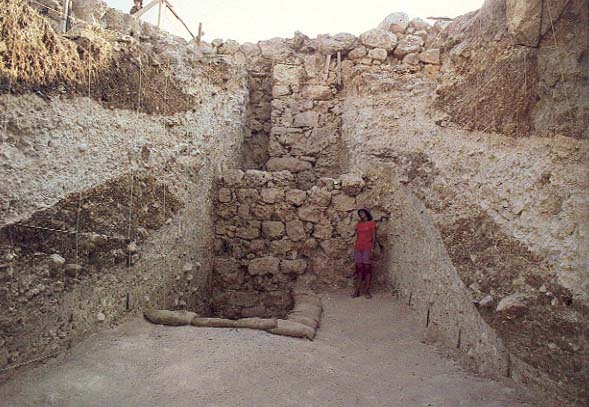
The glacis built against the wall on the outside was constructed in a variety of ways. In the large section cut down to bedrock in Area D, on the eastern and steepest side of the tell, the glacis is especially impressive, both in terms of its strength and because of its colorful layers. The base of the glacis extends about 80 feet from the wall, and its height next to the wall is 20 feet. The angle of declination is about 25°. Buried in the glacis, at a distance of about six feet from the fortification wall, is another wall ten feet high and almost three feet thick that served to stabilize the glacis. Two masses of large rough stones were laid at the base of the glacis; these too served to stabilize the glacis and prevented it from sliding down the slope. The glacis consisted here of five principal layers: reddish-brown earth, white material with small stones, brown and red earthen debris, gray ashy material, and a yellowish 029gray layer at the bottom, found primarily next to the fortification wall and its nearby retaining wall. A “Hyksos” scaraboid with a geometric design was found in the white layer.

In other areas of the tell, the glacis is thinner and less complex. Sometimes it consists of but one relatively thin white layer that was laid directly on bedrock.
Inside the fortification wall, a row of Middle Bronze Age rooms was constructed against the wall in a belt extending for about 350 feet. These rooms were found by us—as well as by the Danish expedition—on the north and northwestern periphery of the tell. The rooms are bounded on one side by the fortification wall and on the other by a wall that was visible only on the inside of the rooms; on the other side of this wall, dirt and stone fill had been dumped. In other words, these rooms were some kind of basement, a fact that explains their impressive preservation—sometimes eight feet above floor level. The floors themselves were composed of beaten earth; in a few places, traces of plaster were found. Between the floors and bedrock there was a filling of light-colored earth, which was about three feet thick.
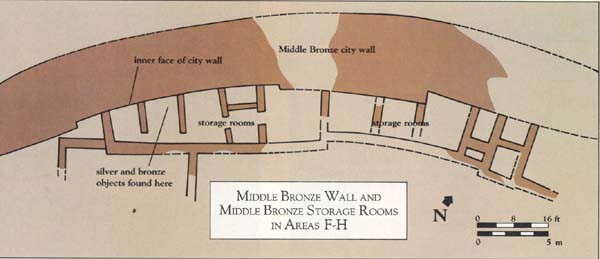
These rooms apparently served as storerooms; large quantities of vessels suitable for storage, but no daily domestic vessels such as cooking pots, were found inside. In Area F each room contained 12–13 huge storage pithoi and other jars, completely filling the limited space of about 60 square feet inside the room.
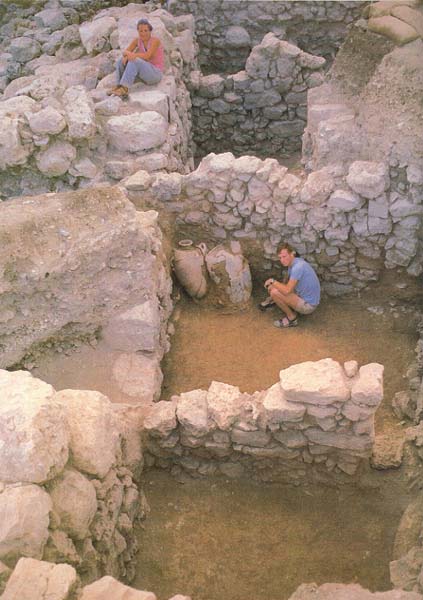
In a corner of one room, we discovered a most 034interesting group of silver and bronze objects; some of them are the only examples found so far in Israel. The bronzes included two large flat axes, a small flat axe, and a large shaft-hole axe of a type principally known in Anatolia and northern Syria. The silver jewelry included a large silver pendant, 4.7 inches (11.8 cm) in diameter, displaying a hammered Cappadocian symbol of a Hittite deity. The storerooms also yielded cultic stands, small votive bowls and a vessel in the shape of a bull. All of this suggests that these rooms—and perhaps all the rooms adjoining the fortification wall at the northern end of the site—were connected to a nearby sanctuary. Additional evidence that a sanctuary existed at Shiloh in the Middle Bronze Age comes from the finds of the Late Bronze Age, which will be described below.

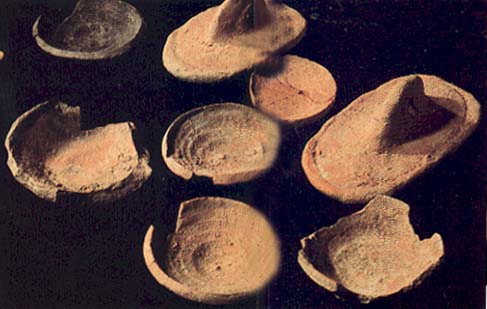
Except for these rooms, no buildings of the Middle Bronze Age were found at Shiloh. In Area D and in the southern part of Area F, only stone and earth fills were found leaning on the fortification wall. Inside the wall, delimiting the belt of rooms on the north of the site, earthen fill was laid that slanted up toward the summit of the tell. Thus the following elements appear in a section through the northern end of the tell (from outside to inside): an earthen glacis, a solid fortification wall built of huge boulders, store rooms with floors laid on a dirt fill that goes down to bedrock, the wall delimiting these rooms, and, behind this, earthen fills slanting toward the top of the hill.
Shiloh was destroyed at the end of the Middle Bronze Age, in the 16th century B.C.3 By whom, we do not know. Traces of burning were found in the rooms along the fortification wall. Before the fleeing inhabitants could remove their belongings, these rooms were often buried under collapsed mudbricks.
Perhaps the most intriguing aspect of the Middle Bronze Age finds at Shiloh is that, already in this period, there appears to have been a shrine at the site. Shiloh thus joins several other sacred Israelite places where a cultic tradition had existed continuously ever since the Middle Bronze Age—long before the Israelite settlement in the 12th–11th centuries B.C.
The total lack of houses in the Middle Bronze Age settlement is also surprising. While it is possible that the residential quarter was at the southern end of the site, an area that could not be excavated because it is covered by the remains of later periods, nevertheless we have exposed enough in the northern part of the site to warrant raising another possibility—that Middle Bronze Age Shiloh was, in fact, mainly a cultic temenos (a sacred precinct) rather than an ordinary settlement.
The massive fortifications, including the great stone wall and the glacis, raise another question. Even if we assume people lived at Shiloh at this time, as at a regular habitation site, we would have to wonder how such a small population managed to execute such an impressive building operation. Calculating population density in the manner generally accepted today, no more than 400 people would have lived at a site of slightly more than four acres. Among these 400 people would be fewer than 100 men. Thus, people from all over the region must have participated in the building activities at Shiloh—a possibility that casts an interesting light on the city’s importance, perhaps as a cult site, already in the Middle Bronze Age.
However, a totally different way to understand the huge fortifications of Shiloh is connected with the pattern of settlement in the vicinity. The survey seems to indicate that some of the small Middle Bronze Age settlements discovered in the Ephraim hill country were abandoned before the end of that period. It is therefore possible that, in the Middle Bronze IIC, the population of these small villages established major, well-defended strongholds, like Shiloh, and found refuge in them.
Finally, there is the matter of the structure of the glacis, which has implications for other sites in the Land of Israel and in neighboring lands. Scholarly opinion is divided as 035to whether the function of the glacis was defensive—to protect the wall itself from enemy seige operations—or constructional—to strengthen the slope of the tell and stabilize the fortification wall. Our excavations indicate that at least at Shiloh, it was constructional. The greatest effort was invested in the glacis at precisely those places where the slope was relatively steep, while on the sides where the slope was more moderate, the glacis was less complex. Indeed, on the eastern slope, the surface of the glacis created a slope even more moderate than the original surface. From this we conclude that the principal motivation for the construction of this earthen glacis was to strengthen the foundations of the fortification wall as well as to counterbalance the pressure of the dirt and stone fills against the inner face of the wall—rather than to prevent an aggressor from approaching it.
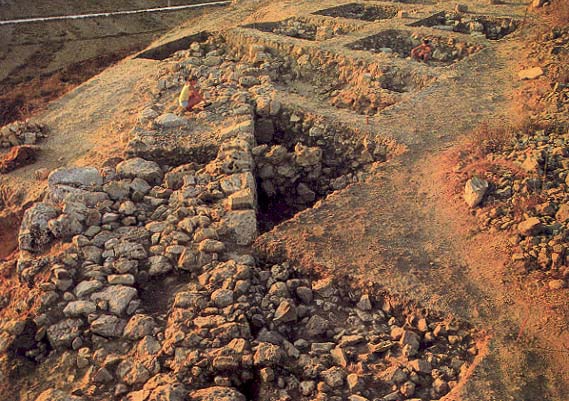
Soon after the destruction of the Middle Bronze stronghold, there was renewed activity at Shiloh, but almost no construction.4 Apart from isolated pottery sherds found in various places on the tell, the Late Bronze Age (15th to 13th centuries B.C.) level was represented only in Area D, extending over an area of about 2,000 square feet; inside and on top of the Middle Bronze fortification wall, there was an accumulation of earth, ashes and stones, nearly five feet thick. This debris contained a very large quantity of broken pottery and animal bones, but no architectural remains. The pottery consists mainly of hundreds of shallow bowls found broken in especially large pieces, as well as juglets, lamps, chalices, imported Cypriote wares, local decorated vessels and a few cooking pots. Several vessels containing ashes and bones were found intact, or nearly so. Most of these vessels appear to have been broken deliberately after use and, together with the bones of animals—probably sacrificial—collected and perhaps even buried in one place.5 Among the small finds were a female figurine, the impression of a cylinder seal on a jar handle, and a piece of gold jewelry in the shape of a fly. On the whole, the debris has the character of a dump or intentional deposit.

Data from all over the tell indicate that there was no real settlement at Shiloh during the Late Bronze Age. Instead, on the summit of the tell, there was probably an isolated cultic place to which offerings were brought by people from various places in the region. The fact that there were very few permanent Late Bronze sites anywhere in the vicinity of Shiloh may indicate that many of these people lived in pastoral groups, in temporary dwellings. It is probable that these offerings, many of them Late Bronze I (15th century B.C.) in date, were brought to the site of the destroyed Middle Bronze Age sanctuary, which may even have been reconstructed. The steadily declining amount of pottery indicates a decrease in activity at the 036site, and then a complete cessation, apparently before the end of the Late Bronze Age.
This accords well with the picture emerging from our survey. During the Late Bronze Age, there was a drastic reduction in population all over the territory of Ephraim. The number of known sites decreased from approximately 50 to 5, and even those settlements were relatively smaller in size.
The Israelite settlement at Shiloh began in the 12th century B.C., at the beginning of Iron Age I, after the tell had been abandoned for some time. We found remains from Iron Age I virtually everywhere we dug. From this period we discovered buildings, stone-lined silos and other remains.
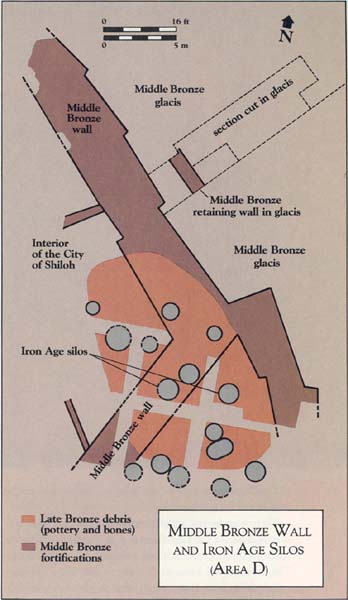
In Area D, adjacent to the inner face of the uppermost course of the Middle Bronze fortification wall, we exposed a rough pebble floor of Iron Age I that continued on top of the Middle Bronze fortification wall. We found no evidence of any permanent structures on this floor. Perhaps the pavement served as a work surface. Lying on the floor were crushed collar-rim store jars, typical Israelite pottery of the period. Among this pottery was a large seal, 1.6 inches (4 cm) in diameter, made from a black stone, and displaying two crossed representations of galloping horned animals.
The most impressive structures of the Iron I period 037were unearthed on the western end of the mound. They indicate that knowledge of building techniques was well developed at a relatively early phase of Israelite settlement. In this area, in a small exposure, the Danish expedition in 1929 found “Houses” A and B, in one of which were the famous collar-rim store jars, which they correctly associated with the Israelite settlement at Shiloh. They did not pursue these excavations because, by their own admission, they encountered difficulties in understanding the character of the area. Our team opened an excavation field immediately to the north of the Danish excavations (our Area C), which we subsequently expanded to join their areas. The buildings we excavated here were erected outside the perimeter of the Middle Bronze fortification wall, which was well preserved here and served as the rear wall of these buildings. When the Iron Age buildings were constructed, a portion of the Middle Bronze glacis was removed, and the side walls of the buildings were built against the continuation of the glacis, so that the Iron Age buildings were actually “sunken” into the Middle Bronze glacis.

The steep slope outside the Middle Bronze Age fortification wall necessitated the creation of two building levels with a terrace wall between them. The Middle Bronze fortification wall evidently served as a retaining wall for additional Iron Age structures erected higher up on the slope. The terrace wall was built of pillars consisting of big flat stones with the space between the pillars filled with small and medium field stones. Behind the terrace walls, fill created a solid flat surface on which the upper-level Iron Age structures were erected, including two pillared buildings separated by a corridor.
One of these buildings, which we call Building 312, had four parallel aisles separated from one another by three rows of pillars. The floor consisted of bedrock, stone slabs and crushed white material from the Middle Bronze Age glacis. In the other pillared building, Building 335, was a courtyard with a beaten earth floor flanked by two rooms carefully paved with stone slabs. Rows of pillars, preserved to a height of three feet, separated the courtyard from the side rooms; a low partition wall joined the pillars of each row. A rock-hewn, plastered cistern was discovered in the courtyard. In the eastern part of the building stood two additional pillars. A large hall was built 039on the lower level of this area, evidently serving as the basement of Building 312. The western wall of this hall was also the outer wall of the site on the side of the slope.
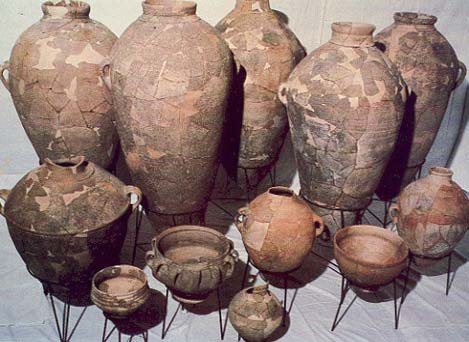
The pottery from these buildings is the richest ever discovered at any early Israelite site, and has implications for the use of the buildings. The Danish expedition uncovered ten whole vessels here; we found over 30 additional vessels and large pieces of many more. Dominating the collection are collar-rim store jars, the storage pithoi that characterize Israelite settlements in the hill country. Altogether, more than 20 of these pithoi have been found over the years, all leaning against walls, and with the bases of some of them inserted into the floor.

The ceramic assemblage also included smaller jars—the handles of one of them stamped by a scaraboid with a geometric design. There were also jugs and kraters. In addition, an ash pit yielded cooking pots. Several grindstones were found in these buildings as well. Carbonized raisins were found in a pile on the floor of one room.

These buildings were destroyed in a fierce conflagration. Burnt floors were found all over. Collapsed burnt bricks accumulated on these floors to a height of more than three feet. Some of the bricks had been baked by the blaze that had raged here. Roof collapse was discernible in many places. All this dramatic evidence of fire must be associated with the destruction of Shiloh by the Philistines after they defeated the Israelites near Ebenezer in the mid-11th century B.C. Jeremiah knew what he was talking about when he later threatened the people with destruction like Shiloh’s.
In the debris on top of the brick collapse in one of the pillared buildings, we found evidence of cultic activity in Iron Age I. Two pottery sherds were decorated in relief with animal figures—the head of a lioness and a ram’s head. We also found fragments of a cultic stand with relief images of a horse, a lioness and a scene of a leopard attacking a deer. Near the summit of the tell, we found an Iron Age I installation with several collar-rim jars inside. Fourteen Iron Age silos, each about five feet in diameter were found in the northwest part of the hill (Area D); in two of these silos we discovered huge quantities of carbonized wheat. On the southern side of the tell Iron Age I remains were also found in what must have been a garbage dump (this discovery indicated to us the southern limit of the occupation at this time). Among the finds here was a practically complete rim of a collar-rim store jar with three rosettes stamped on it.6
What can we conclude from over four years of excavation and survey?
One of the surprising results of our work at Shiloh relates to the period before the Israelite settlement. There are accumulating indications of cultic continuity at the site—from the Middle Bronze II period onward; that is, the sacral tradition at Shiloh long antedates the Israelites! A sanctuary probably stood here as early as the Middle Bronze Age, and this may have been of central importance to the development of the site. Even after the destruction of the fortified Middle Bronze site, with its massive glacis, cultic activity continued in the Late Bronze Age, despite the absence, as far as can be determined, of any real settlement. I previously noted the possibility that Shiloh may have then become a central cultic site serving the population of the surrounding area, especially in the first part of the Late Bronze I (LB I).
The history of Shiloh in the Middle and Late Bronze Ages helps us to understand why Shiloh was chosen as the first Israelite sacred center.
Our work at Shiloh may help solve another puzzle: In the past, scholars have been divided as to the chronological order of Israel’s cult centers during Iron Age I. In short, which came first, Shiloh, Shechem, Bethel or Gilgal? The question is too complicated to go into at length here, except to note that the intensive surveys being conducted now throughout of the entire central hill country indicate that the regions with the greatest concentrations of early Israelite settlements are in the territories of Manasseh and Ephraim—in the north—and that from there the Israelite population spread southward, to Benjamin and Judah. It can therefore be hypothesized that the earliest cult center was in the north, probably in Ephraim. Benjamin grew in importance only after the density of the Israelite population in the hill country moved south in succeeding phases of Iron Age I. It would seem therefore that Shiloh preceded Bethel and 040Gilgal as cult centers serving the people of the hill country. The question of Shechem remains an open one.
Why, among all the sites in Manasseh and Ephraim, was Shiloh chosen? The early sacral traditions associated with the site and the fact that there was no flourishing Canaanite city here in the Late Bronze Age, on the eve of Israelite settlement, must have been contributing factors. But no less important was the pattern of settlement in the northern part of the central hill country, as revealed in the surveys. The territory of Ephraim was practically uninhabited by a sedentary population just prior to the extensive Israelite settlement. Manasseh, on the other hand, as both the Bible and archaeological evidence reflect, was settled with a sizable, well-established Canaanite population, among whom the Israelites had to find places for themselves. The Canaanite population continued to inhabit Manasseh for a long time after the Israelites arrived on the scene.
In short, at the beginning of the Israelite settlement, Shiloh was an outstanding candidate among the sites of the region because it was an old cult site that now stood deserted in an area with only the sparsest Canaanite population.
The results of our excavations at Shiloh also shed light on important chronological issues concerning the process of Israelite settlement. First of all, it is now clear that Yohanan Aharoni’s view,b which seemed to prevail several years ago, that Shiloh may furnish evidence for raising the beginning of Israelite settlement to the 14th and 13th centuries B.C., is no longer valid. Instead, Shiloh fits the pattern now emerging all over the country—there is no unequivocal archaeological evidence that Israelite settlement began as early as the 13th century B.C.
Another issue involves the date when Shiloh became an Israelite cult center. From our hypothesis that Shiloh was the first of the sacred sites in the hill country, it follows that this date should be regarded as the earliest archaeological evidence for the organization of the Israelite population within a framework broader than isolated local groupings. In light of all the data presently at hand, the erection on the western slope of the public pillared buildings, which, in our opinion, were annexes to the cultic complex that stood farther uphill, took place no earlier than the second half or end of the 12th century B.C. Such a date for the creation of the first supratribal center accords, to the best of our knowledge, with all the other chronological evidence, especially the date of the beginning of the process of Israelite settlement.
No doubt the cultic center at Shiloh also played an important economic role in the lives of the inhabitants of the hill country, as attested both by our excavation and our survey Storage vessels predominate in the assemblage uncovered in Area C; in an area no larger than 2,700 square feet (250 square meters), more than 20 large pithoi, seven jars and three kraters were found. Although a few cooking pots were also discovered here, this is no ordinary domestic assemblage, and it seems that at least parts of these buildings were used for storage.
The inability to excavate the higher area of the tell, which was eroded and damaged by later building activity, is an impediment to any attempt to draw conclusions about the plan of this early settlement. As I indicated, it is likely that these storerooms were in some way connected to the sanctuary and that perhaps the offerings brought to the sanctuary (see 1 Samuel 1:24) were stored here. If this was the case, these structures would be the only public buildings known in the hill country in Iron Age I (c. 1200–1000 B.C.).
As for the regional settlement pattern, our survey indicates that population density in the immediate vicinity of Shiloh was two and even three times greater than at other places in the territory of Ephraim. Some 100 sites of Israelite settlement have been found so far in our survey, of which 22 are apparently within a radius of about three to four miles of Shiloh. By comparison, in a similar radius around Bethel, only 12 sites from this period were discovered; moreover, as far as we can tell, at least half of these settlements near Shiloh began at a later phase of Iron Age I, when the site reached its zenith. It is clear, then, that the density of population in the region was influenced by the cultic and economic center of Shiloh.
The area of the Iron Age I site was only about three acres;7 most of it was probably occupied by the complex of the tabernacle and its auxiliary buildings. Was Shiloh, in addition, an ordinary settlement or was it strictly a sacred temenos with annexes? The answer to this question can only be obtained on the southern slope of the tell. Unfortunately, it is precisely this area that was so damaged by later construction as to render the chances of uncovering any early architecture here exceedingly slim. The question must, therefore, remain open for the time being. However, if the finds described above and the character of the site in the Bronze Age are any indication, then it would seem more likely that it was mainly a sacred temenos.
Finally, we must touch upon the tantalizing but unanswerable question about the location of the tabernacle. Various hypotheses have been suggested. Charles Wilson, who visited the site in the 1870s on behalf of the London-based Palestine Exploration Fund, suggested that 041the tabernacle stood on a natural rock surface just north of the tell; he based his suggestion on the many indications of hewing discernible on this flat area. Wilson’s proposal still finds some supporters today. However, recent excavations in this area undertaken by Ze’ev Yeivin of the Israel Department of Antiquities turned up no remains whatsoever of the Iron I period.
Nor have our excavations on the mound itself given an unequivocal answer to the question of the location of the tabernacle. We did find a few clues, however. For example, there is the negative evidence from the northern part of the tell, where no architectural remains of Iron I were found. So, assuming that the sanctuary was situated on the mound itself—and few would dispute this—the only other possible locations are the summit and the southern slope. There seem to be several points in favor of the summit. The amount of effort expended in erecting the pillared buildings on the steep slope—a segment of the Middle Bronze glacis was removed to create a level construction site—is astounding, especially given that the more moderate and convenient area on the northern side was free of buildings and therefore available. It is indeed hard to understand the decision to erect the pillared buildings on the slope unless they were planned and constructed as part of a larger complex, the greater part of which was to their east, in the direction of the summit; in other words, these pillared buildings were at the back of the complex.
Some support for this line of reasoning may be garnered from the debris found overlying the collapsed bricks of the pillared building we call Building 335. As noted above, this debris contained fragments of a cultic stand and other vessels ornamented in applied relief that may have been offering vessels. Where did this debris originate? The most likely explanation is that the material was dumped down the slope at a later period, when the area adjacent to it on the east, in the direction of the summit, was cleared in preparation for new construction. Our attempts to investigate the upper reaches of the tell, just east of Area C, were unsuccessful because the intensive Roman and Byzantine building operations had destroyed all earlier remains.
After the Philistine destruction of Shiloh in the middle of the 11th century B.C., the center of Israelite population moved southward, to the hilly territory of Benjamin. Shiloh lost its claim to prominence, and no important town ever arose here again. Following a period of abandonment, a small village, the poor remains of which were found in several places, occupied the site in Iron Age II (tenth to eighth centuries B.C.). The Danish expedition uncovered various Roman remains, as well as two Byzantine churches with ornamental mosaic floors south of the mound. We also found Hellenistic, Roman and Byzantine remains in various places on the tell. But the days of glory for Shiloh were over. As the Bible reflects, and our excavations confirm, Shiloh never really recovered from the Philistine destruction in about 1050 B.C.
The unattributed photographs in this article were taken by Moshe Weinberg, Michal Roche-Ben Ami and the author.
Bibliography
The Danish Excavations
Hans Kjaer, “The Excavation of Shiloh 1929,” Journal of the Palestinian Oriental Society 10 (1930), pp. 87–174.
Hans Kjaer, “A Summary Report of the Second Danish Expedition, 1939,” Palestine Exploration Fund Quarterly Statement (1931), pp. 71–88.
Marie-Louise Buhl and Svend Holm-Nielsen, Shiloh, The Danish Excavations at Tell Sailu
Yigal Shiloh, Review of Buhl and Holm-Neilsen, “Shiloh,” Israel Exploration Journal 21 (1971), pp. 67–69.
Yohanan Aharoni, “The Ten Thousands of Ephraim and the Thousands of Manasseh,” in Eretz Shomron (in Hebrew), p. 46.
Recent Excavations
Israel Finkelstein and Baruch Brandl, “A Group of Metal Objects from Shiloh,” The Israel Museum Journal IV (1985), pp. 17–76.
Israel Finkelstein (editor), “Shiloh Excavations 1981–1984, Preliminary Report,” forthcoming in Tel Aviv.
In the first half of the 11th century B.C., Shiloh was one of the most important sites in the central mountain ridge that runs through the Land of Israel. Here was the sacred religious center of the Israelite population of the hill country. Here the Ark of the Covenant rested within the Tabernacle for nearly a century, until the Ark itself was captured by the Philistines in the battle of Ebenezer (1 Samuel 4). Here Eli served as high priest. Here Samuel, prophet and seer, grew up and served the Lord. Interestingly enough, Shiloh is not mentioned in the […]
You have already read your free article for this month. Please join the BAS Library or become an All Access member of BAS to gain full access to this article and so much more.
Already a library member? Log in here.
Institution user? Log in with your IP address or Username
Footnotes
Endnotes
The expedition was directed by Israel Finkelstein with the assistance of Shlomo Bunimowitch and Zvi Lederman (who was also the surveyor). Permanent members of the archaeological staff were Pnina Ben-Hanania and Ariella Cohen (registration); Mordechai Kislev (paleobotany); Aharon Demsky; Robert Kaufman (organization of volunteers); Moshe Weinberg (photography); Amalia Katznelson (restoration); Bernardina Luttinger (drafting); Amir Feldstein, Michal Iron-Lubin and Shmuel Yoseph (area supervisors). Students of the Department of Land of Israel Studies at Bar-Ilan University, youth group members and volunteers from Israel and abroad participated in the excavations. Many official institutions and individuals aided the work of our expedition: the National Council for Research and Development, the Israel Defense Forces, the Archaeological Staff Officer for Judea and Samaria, the Cherna and Dr. Erving Moskovitz Chair for the Study of the Land of Israel (Bar-Ilan University), Ludwig Jesselson (USA), Ernest Strauss (Switzerland), Oved Ben-Ami (Israel), the Dorot Foundation (USA), the Regional Council of Benjamin, the Jewish Agency and the Jewish National Fund. Dr. Daniella Saltz translated the manuscript.
In the 1969 publication of the results of the Danish Expedition (see Bibliography), Marie-Louise Buhl fixed the beginning of occupation at Shiloh in the Early Bronze Age, based on her impression of a few isolated sherds. However, our excavations have not produced even one single sherd of that era. The Early Bronze settlement in that fertile valley was at Khirbet er-Rafid, situated 1,000 yards (900 meters) southwest of our mound.
The date of the destruction was determined by the pottery assemblage unearthed in the storerooms in Areas F and H. A sherd of “chocolate-on-white” ware found in one of the rooms is of particular importance, for this type does not antedate the 16th century B.C.
The Danish expedition dated wall AA, found in their northwestern area, to the Late Bronze Age and described it as a fortification wall. Our reinvestigation found this to be a Byzantine terrace.
Various evidence suggests that the debris was brought to Area D at a later date—and it seems that the original burial site was cleared out in Iron Age I, in the course of new building operations carried out on and around the summit.

